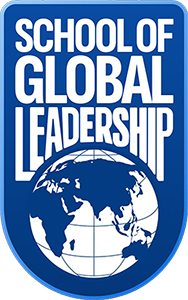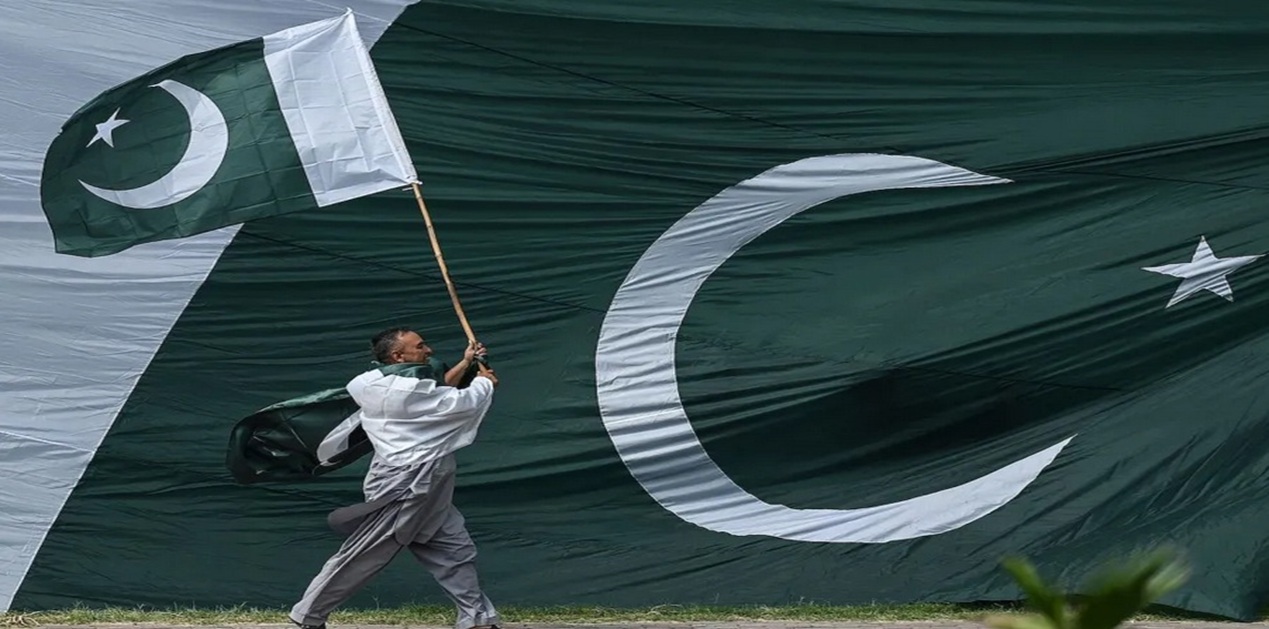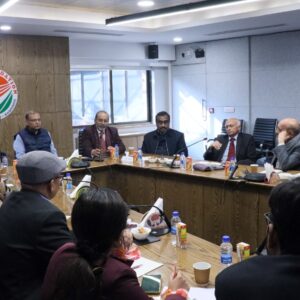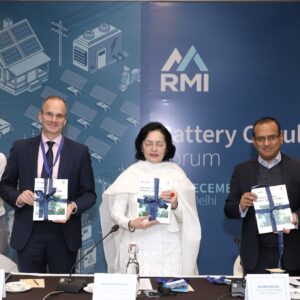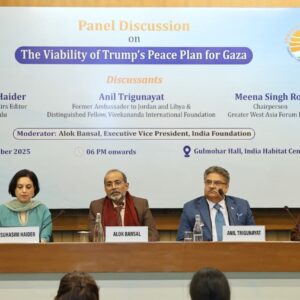On 14 August 2025, Pakistan celebrated its 79th Independence Day.[1] The occasion was marked by a 31-gun salute in the Islamabad Capital Territory and 21-gun salutes in provincial capitals, presided over by the Prime Minister and the respective Chief Ministers of the provinces. The Independence Day celebrations took place against a backdrop of relative peace and strict security in Khyber Pakhtunkhwa and Balochistan. Nevertheless, it saw muted protests in Quetta and Kalat by Baloch nationalist elements, who marked the day as a ‘black day’[2] and protested against the continued imprisonment of Dr Mahrang Baloch,[3] the founder of Baloch Yekjeheti Conference, along with several Baloch civil rights activists.
Marka-i-Haq: Of Meta-Narratives of Piety and Legitimacy
This Independence Day was notable for another reason: the government and the Army, beyond celebrating Independence Day, also marked it as the “victory” of ‘Marka-i-Haq’[4] or the “war of righteousness.” It marks the end of the conflict between India and Pakistan that erupted in early May, after India launched Operation Sindoor in response to the terrorist strike in Pahalgam. Nationalist fervour was, therefore, quite vocal, with the Prime Minister addressing the nation from Jinnah Sports Stadium, Pakistan’s largest stadium in the centre of Islamabad, on the eve of Independence Day. The festivities at the stadium included marching contingents from Türkiye and Azerbaijan, which had provided moral and material support to Pakistan during and after the conflict, as well as representation from Pakistan’s armed forces.
A brief analysis of Shehbaz Sharif’s speeches over the years on Pakistan’s Independence Day, first as the Chief Minister of Punjab and later as Pakistan’s Prime Minister since 2022, shows a clear shift: the speech was infused with nationalist slogans aimed at emphasising a collective ‘bond of faith’ [5]strengthened by defending the country during the conflict with India, led by the government and the military establishment (referred to hereafter as the Establishment).
The infusion of virtue and righteousness in his rhetoric constructed a Manichean binary between Pakistan and its adversary, in this case India. In creating this Manichean, moralistic binary to justify Pakistan’s Operation Bunyan Marsoos,[6] Sharif was, in effect, trying to reaffirm the legitimacy of the hybrid regime, which was cloaked in a febrile legitimacy afforded by a widely disputed electoral verdict, as the protector of Pakistan as well as its Islamic identity. In addition to noting the military’s role and the ‘resolve of the citizens’, Sharif expressed gratitude to China, Türkiye, Azerbaijan, Saudi Arabia, the UAE, and, especially, President Trump for their diplomacy, thereby reaffirming the alliances that fructified in the lead-up to, and were strengthened during, the May conflict.
Sharif’s speech may have diverged from the calculated political correctness he was previously associated with; instead, his confrontational, masculine rhetoric now resembles that of Imran Khan, his predecessor and arch-rival, who is currently in prison. The moral undertones and lavish allusions to Pakistan’s Islamic identity were borrowed from the Islamist playbook of the Pakistan Tehreek-i-Insaaf, particularly Khan, and aim not only to pacify the current surge in nationalism but also to serve two additional purposes: firstly, domestically, it reaffirms Pakistan’s Islamic identity, thereby strengthening unity to symbolically shift Pakistan’s eruptive partisan and ethno-linguistic fault-lines, which will be discussed later in this article.
But secondly, and perhaps as an understatement, Sharif’s rhetoric intensified Pakistan’s outreach to its partners in the Organisation of Islamic Cooperation, especially the Gulf monarchies and Turkey; Pakistan was instrumental in founding and shaping the idea of OIC,[7] and the country prioritises its OIC relations in its foreign policy as it is its only nuclear power and second-largest member. While giving special importance to OIC is not new, embedding it in notions of piety and using it as a basis for a moralistic foreign policy is indeed an inheritance from Khan’s Islamist populism. Additionally, according to data from the Ministry of Overseas Pakistanis and Human Resource Development, out of 9.9 million Overseas Pakistanis, over 52% reside in OIC member states, particularly in the Gulf.[8]
Nationalism in the Name of Islam: An Oxymoron and a Community Unimagined
But the appeals to Islamic piety and the ummah, as espoused in the OIC Charter concur with a paradox: On one hand, juxtaposed against military parades and masculine portrayals of the nationhood—as demonstrated in the Marka-i-Haq celebrations in Islamabad, Lahore, and Karachi—and the announcement of a Rocket Force Command, indicate that these appeals originate from a position of strength. On the other hand, Sharif’s constant invocation of Islamist rhetoric seeks to mask Pakistan’s societal fragility: a master narrative of the Marka-i-Haq endures the rally-around-the-flag effect achieved during Operation Bunyan Marsoos.
However, the attempt to mask Pakistan’s internal divisions through Islam remains futile. While the idea of a homeland for South Asia’s Muslims forms the core of Pakistan’s founding myth,[9] it has been consistently challenged. For example, ethno-nationalist movements across Pakistan and the desire for a sense of normalcy and strength led to the pre-emptive suspension of Internet services in Balochistan, igniting protests. Baloch activists continue to face armed resistance as their protests to secure the release of Mahrang Baloch and other members of the Baloch Yakjehti Conference have been met with fierce opposition. In 2024, Balochistan saw a remarkable rise in violent attacks and casualties, with an 84 per cent increase over 2023, resulting in 322 lives lost and 534 others injured in 202 incidents.
Militant nationalist groups such as the Baloch Liberation Army (BLA) and the Balochistan Liberation Front (BLF) significantly increased their attacks. They targeted security forces, civilians, and non-Baloch workers, miners and travellers.[10] They have carried out some high-profile attacks, including hijacking an entire train, Jaffar Express, in March 2025. In July 2025, BLF launched coordinated attacks across 17 locations in Balochistan. These incidents not only demonstrate their extensive reach, but also the overwhelming support of the local population, showing their alienation from Pakistan.
Terrorism continues to unsettle life in Pakistan’s western frontier. In July 2025 alone, 91 incidents of killing were reported, in which 60 victims were civilians. Five were killed and 11 injured in a roadside bombing in Bajaur. Four security forces personnel were killed as 150 terrorists of the Tehreek-i-Taliban opened fire in Orakzai. 2024 was the bloodiest year in the recent past, when 852 persons were killed and 1092 injured in 521 terrorist attacks. Over 95 per cent of these attacks were concentrated in the provinces of Balochistan and Khyber Pakhtunkhwa.[11] There were 785 violent incidents in total, which included operations by security forces and resulted in the killing of 1950 and injuries to 1850 others.[12]
The deteriorating internal security situation has led to the launch of Operation Azm-i-Istekham. It is a counter-terrorism, kinetic operation aimed at reconciling with the changing regional realities, such as terror attacks on Chinese citizens working on projects of the China–Pakistan Economic Corridor, attacks on migrant workers from Punjab in Balochistan, and a surge in activities of the TTP since the return of the Taliban regime in Afghanistan in 2021.
A spate of terror incidents, highlighted by the attack in a school in Peshawar in 2014, had precipitated the launch of a National Action Plan (NAP)[13] to combat terrorism. It included kinetic measures as well as non-kinetic approaches such as promoting regional autonomy in radicalised areas like the then Federally Administered Tribal Agency (FATA), poverty alleviation, and reconciliation dialogues. The Jaffar Express bombing in March this year has prompted calls from the Pakistan People’s Party chief Bilawal Bhutto–Zardari to launch an NAP-II to address current challenges.
His remarks were followed by Asim Munir’s diatribe in the Pakistani Parliament, after the convening of the National Security Committee that month, where he admonished the failure of successive governments in containing terrorism, advocating for a “hard state.”[14] His comments ignited debate in Pakistani civil society about the feasibility of this approach, especially vis-à-vis Pakistan’s declining trend in human rights. And although commentators have remarked on the futility of extrajudicial law enforcement processes, Pakistan’s history offers few alternative approaches.
State Capacity—or the Lack Thereof
However, the dichotomy between a hard and a soft state is often misconstrued in these commentaries: a hard state does not necessarily imply a hardline state. The distinction lies in state capacity: Pakistan has not been able to expand state responsiveness and readiness to face threats. State expansion has been hindered by anaemic institution-building, which has routinely fallen into the hands of the Establishment. To understand the laxity in Pakistan’s state capacity, it is essential to understand the rise and fall of Mohajirs.
Pakistan’s weak state capacity is, arguably, rooted in its problematic origin, whereby it inherited a smaller financial and bureaucratic apparatus than India, the latter quickly populated by educated, Urdu-speaking, middle-class,[15] and upwardly mobile Mohajirs from India.
Pakistani censuses conducted between the 1950s and 1970s reveal the extent of their dominance. By 1970, they held nearly a third of administrative positions within Pakistan’s bureaucracy and controlled more than ten of the top positions in the military. Businesspeople who had migrated from India’s coastal regions controlled some of Pakistan’s largest corporate and media houses. While Liaquat Ali’s administration introduced a quota to increase the representation of Bengalis and check the overbearing influence of the Mohajirs, it did not diminish their social and economic capital, especially in the upper echelons of the bureaucracy. Their disproportionate access to public goods like education meant that the passage of the One Unit Plan intensified this polarisation. However, their fortunes declined with the inauguration of Islamabad as the national capital, coinciding with the first military regime of Pakistan under Ayub Khan and the subsequent expansion of Punjabi dominance in civil and political affairs.
Subsequently, the arrival of Zulfiqar Ali Bhutto and the PPP’s policies, such as the Sindhi Language Bill and the introduction of quotas in the Sindh Government, marginalised the Mohajirs. Karachi, Pakistan’s economic centre and the heartland of the Mohajirs, also saw the growth of Pashtun, Sindhi, and Baloch immigrants, and disputes over its limited resources led to ethnic riots, notably in the 1980s, when Altaf Hussain’s All Mohajir Student Organisation mobilised against what they saw as discriminatory practices by the state. Later becoming the Muttahida Qaumi Movement (MQM), the party was arguably positioned as a counterbalance to the PPP, gaining support from the Establishment and ruling Karachi through mobocracy.[16]
The lack of state capacity in Pakistan’s largest city is exemplified by what Laurent Gayer described as ‘ordered disorder’ of Bhatta extortions, ethnic enclaves, mob justice, and the erosion of law and order due to the MQM’s cadres.
Following Operation Clean-Up in 1992, the MQM’s influence diminished for some time. However, it consolidated control over Karachi’s political economy by initially supporting Musharraf and later by becoming part of most federal governments. Its legitimacy waned when the Lawyers’ Movement in Pakistan gained strength and demanded democratisation, leading to Musharraf’s resignation. Its ultimate downfall occurred after its leader Altaf Hussain delivered a vitriolic anti-Pakistan speech from London in August 2016. The speech triggered a harsh crackdown, resulting in the party’s fragmentation and the decline of Mohajir influence in Karachi. As the most socio-economically developed community in Pakistan, Mohajirs have the lowest birth rate among various ethnic groups. Coupled with the large-scale migration of Pakhtoons, Baloch and Sindhis to Karachi, this has reduced the Mohajir population in the city to less than half, weakening their stranglehold over Pakistan’s financial hub. The MQM’s current version is supported by the Establishment; therefore, despite regaining control over Karachi and Hyderabad—albeit through a widely considered rigged election—the party has lost support without a charismatic leader like Altaf. This decline has heightened Mohajir insecurities and increased their alienation from the state. The alienation of Mohajirs, who are considered the founders and ideologues of the idea of Pakistan, clearly demonstrates that a shared religion has failed to bridge ethnic divisions.
At the other end of the political spectrum in Sindh, the Sindhi identity is experiencing a resurgence. Since the death of GM Syed, a counterpart to the Jiye Sindh Movement has been difficult to identify.[17] The rise of the Pakistan Peoples Party (PPP) and consequently the Bhuttos in national politics gave Sindhis a stake in the national arena and lessened their perceived marginalisation, initially vis-à-vis the Mohajirs and later vis-à-vis the Punjabis. However, the assassination of the two PPP Prime Ministers from Sindh—Zulfiqar Ali Bhutto and Benazir Bhutto—transformed their sense of ‘victimhood’ into anger against the Punjabi-dominated military. While the PPP’s vote share has increased in successive elections, its influence has become more concentrated in rural Sindh.
Since the announcement of the Cholistan irrigation project by the Army Chief, protests have erupted against what Sindh regards as the diversion of its rightful share of the Indus waters. The project, which aims to irrigate large areas of land in the Cholistan desert in Southern Punjab by constructing new canals from the Indus, has naturally caused concern in Sindh, which derives its name from the river.[18]
The province relies heavily on the river to sustain its agricultural economy. Already, the rising salinity from the sea has rendered large areas of fertile land barren; the Cholistan canal project will further diminish downstream flow, increasing salinity. This is expected to damage 12 million hectares of cultivated land. As a result, despite receiving unequivocal support from the Establishment, the canal project has been halted amidst protests from groups advocating for Sindh’s regional autonomy, such as the Jeay Sindh Markaz. However, the issue-specific movement has gained a broader scope thanks to the leadership of Zulfiqar Ali Bhutto Jr, who, along with his sister Fatima Bhutto, has decided to establish a political party in Sindh, complicating the internal disputes of their father with the Bhutto-Zardaris. His fashion choices and combination of urban, ecological, and rural concerns signal a challenge to the PPP’s Sindhi vote-bank.
With the Cholistan dispute,[19] the PPP found itself in a quagmire, and hence the inaction. The PPP, since the departure of Shah Mahmood Qureshi[20] and the trickling away of the ‘electables’, especially the sajjda-nashins of Southern Punjab and the Sairaiki belt, has been seeking to stage a comeback in the region and, by extension, in Punjab. The canals were supposed to benefit the farmers of South Punjab, but risked putting the citizens of Sindh, the rain-impoverished province, in peril, which, incidentally, is also the PPP’s bastion.
The exposition of Pakistan’s hard military power, amidst the absence of adequate state capacity, will be most evident on Pakistan’s restive Western frontier. Khyber-Pakhtunkhwa, bordering Afghanistan, has been at the fulcrum of the spike in terrorist incidents since the return of the Taliban regime. KP has also borne the brunt of Pakistan’s malfunctioning state identity. [21]Even at the time of Independence, calls for territorial autonomy and a potential merger of the Pashtun-populated lands of Pakistan and Afghanistan had threatened the foundations of the State. The Jamaat has had a sizeable presence in the ethnically diverse region. Madiha Afzal[22] has written about the high concentration of madrasas and Islamic seminaries in the province. Symptomatic of state incapacity, over 2 million children in Pakistan have to attain education in madrasas, over 1.2 million of whom live in KP. Musharraf’s attempts at containing Islamism in the early 2000s also influenced the madrasas, as the Madrasa Education Board was established in 2001. However, madrasa reform is in a constant conflictual dialectic with the forces of religiosity and, since the fall of Musharraf, has been a stillborn idea.
In Khyber Pakhtunkhwa (KP), the expanding scope of the Council of Islamic Ideology (CII) has gained significant influence because of the province’s deeply conservative social fabric and the strong presence of Islamist parties such as Jamiat Ulema-e-Islam (Fazl) (JUI-F). The CII’s statements on family law, women’s rights, educational curricula, and cultural practices often have a strong impact in KP, where local political elites and religious leaders frequently invoke its authority to oppose reformist initiatives. Scholars observe that although the CII is officially advisory, in practice its opinions “shape the boundaries of legislative debate” in places like KP, where government institutions grapple with social conservatism and the legacies of militancy. As a result, the Council’s widened role has reinforced traditionalist trends in KP, restricting progressive laws on gender and education, while also providing religious justification for policies that further solidify Islamist influence in provincial politics.[23]
Since 2013, the co-option of Islamists in the province has propelled the PTI to power; today, despite the restrictions on its activities, PTI-backed Independents have formed a diverse political coalition to govern the province, often conflicting with the party’s leadership in Islamabad.
Balochistan epitomises Pakistan’s governance crisis, where political marginalisation, resource exploitation, and heavy securitisation converge to fuel chronic instability. Despite being the largest province and rich in natural resources, it remains the poorest, with grievances over exclusion from decision-making and inadequate revenue-sharing.[24] Recurrent insurgencies, enforced disappearances, and militarised responses have deepened alienation. Recent attacks on Chinese interests linked to the China–Pakistan Economic Corridor (CPEC) highlight how Balochistan’s discontent undermines state legitimacy and poses a strategic liability for Pakistan’s regional ambitions.
Balochistan remains Pakistan’s most intractable internal challenge, marked by chronic underdevelopment, political exclusion, and recurring insurgency. Although it is the largest province in terms of territory and is endowed with vast mineral and energy resources, its population faces some of the worst socio-economic indicators in the country, characterised by persistent poverty, inadequate education, and limited access to healthcare. Grievances are rooted in long-standing perceptions of exploitation—Islamabad’s control over natural gas revenues since the 1950s and more recent projects under the China–Pakistan Economic Corridor (CPEC) have heightened local resentment over resource extraction without equitable benefit-sharing.[25]
The state’s reliance on militarised governance, including enforced disappearances and extrajudicial killings, has deepened mistrust and alienation, creating cycles of rebellion and repression. Insurgencies led by Baloch nationalist groups have ebbed and flowed but remain a low-intensity conflict, occasionally destabilising Gwadar and targeting Chinese investments, thereby complicating Pakistan’s strategic and economic ambitions. Politically, the province is fragmented: mainstream parties often lack legitimacy at the grassroots level, while nationalist groups are systematically marginalised, leaving little scope for democratic reconciliation. This disconnect highlights that Balochistan’s crisis is not just local unrest but a key challenge for Pakistan in handling ethnic diversity, resource allocation, and federal governance.
Pakistan’s government recognises that many of its internal conflicts are intractable and that the basis of Islam is unstable, making economic growth essential. It remains hindered by structural weaknesses; however, it has negotiated a staff-level agreement with the IMF and approved over $2 billion in funding. It has also negotiated a trade agreement with the US, which is expected to benefit its fledgling industry. Pakistan’s economy follows a boom-and-bust cycle.[26] Funding from Western lenders triggers a consumerist cycle, which eventually results in increasingly unsustainable import bills that lead to a foreign exchange crisis. However, at present, Pakistan’s falling inflation and rising activity in the Karachi Stock Exchange suggest the country is experiencing a boom cycle.
In sum, Pakistan survives in a paradox:[27] instability amidst resilience. However, the challenges of state capacity are increasing. Pakistan’s current difficulties highlight the uneasy balance between apparent strength and real weakness. The Sharif government’s use of religious symbolism and military victories aims to project unity and legitimacy, but beneath this façade lie lasting divisions: Baloch alienation, the instability in Khyber Pakhtunkhwa, the fragmentation of Mohajir politics, and the entrenched control of dynastic elites in Sindh and Punjab. The shift between tough security policies and rhetorical appeals to Islamic unity has done little to genuinely expand the state’s ability to address these issues through inclusive governance, fair resource distribution, or institutional reform. Simultaneously, the country’s economic weakness—marked by cycles of debt, dependence, and brief periods of growth—worsens internal instability, even though renewed IMF support and new trade prospects with the United States temporarily ease pressures.
Pakistan’s challenge, therefore, is not just to survive immediate crises through force or external aid but to fundamentally change the relationship between the state and society, prioritising economic stability, accountable governance, and social unity over the persistent reliance on militarisation and religious symbolism. Until this realignment occurs, Pakistan’s politics will remain trapped between the illusion of strength and ongoing vulnerability.
Author Brief Bios:
Capt. Alok Bansal is the Executive Vice-President of India Foundation & the Secretary General of Asian Eurasian Human Rights Forum (AEHRF). A seasoned strategic affairs analyst, he has previously served as the Executive Director of the National Maritime Foundation (NMF) and has held research positions at leading Indian think tanks including the Institute for Defence Studies and Analyses (IDSA) and the Centre for Land Warfare Studies (CLAWS). He has authored/ edited 10 books. His work focuses on maritime security, South Asian geopolitics, and internal dynamics of Pakistan. A former naval officer, he served in the Indian Navy for 32 years and commanded two warships. A PhD in international Affairs, he has been a visiting Professor at Jamia Millia Islamia.
Parth Seth is a Research Fellow at the India Foundation. His interest lies in the themes of multilateralism, development, middle powers, and great power competition. He focuses on South Asia, the Middle East and North Africa (MENA), and Chinese foreign policy. While interning at several think tanks, he has assisted researchers in the domains of strategic studies, public policy, and international development. He has written for websites and journals on the themes of South Asia, China, MENA, and the intersection of political philosophy and policy. He completed his postgraduate studies in International Relations from the London School of Economics and Political Science and holds an undergraduate degree in political science from the Ramjas College of the University of Delhi.
References:
[1] https://tribune.com.pk/story/2561251/world-leaders-congratulate-pakistan-on-independence-day
[2] https://edition.cnn.com/2024/11/26/asia/pakistan-protests-imran-khan-islamabad-explainer-intl-hnk
[3] https://time.com/7292408/mahrang-baloch-arrest-balochistan-pakistan/
[4] https://www.radio.gov.pk/12-05-2025/military-campaign-marka-e-comes-to-victorious-end
[5] https://global.oup.com/academic/product/righteous-demagogues-9780197756928?cc=us&lang=en&
[6] https://www.aljazeera.com/news/2025/5/10/pakistan-launches-operation-bunyan-marsoos-what-we-know-so-far
[7] https://treaties.un.org/doc/Publication/UNTS/Volume%20914/volume-914-I-13039-English.pdf
[8] https://pakistan.iom.int/sites/g/files/tmzbdl1121/files/documents/2024-05/pak_2023_migrant-presence_fms_final.pdf
[9] https://www.hurstpublishers.com/book/muslim-zion/
[10] “Pakistan Security Report 2024: An Abridged Version”, Islamabad, Pak Institute for Peace Studies, Vol 17, January 2025, No 1, p. 6.
[11] Ibid,.
[12] Ibid., p. 8.
[13] https://nacta.gov.pk/laws-policies/nap-2014/
[14] https://www.thehindu.com/news/international/pakistan-army-chief-calls-for-turning-country-into-hard-state-in-fight-against-terrorism/article69347261.ece
[15] https://www.brookings.edu/books/the-idea-of-pakistan/
[16] https://www.hurstpublishers.com/book/karachi/
[17] https://academic.oup.com/book/39290
[18] Indus is called Sindhu in Urdu.
[19] https://www.thefridaytimes.com/29-Mar-2025/cholistan-canal-controversy-water-crisis-and-environmental-risks-in-pakistan
[20] https://www.dawn.com/news/676336/shah-mehmood-qureshi-joins-pakistan-tehrik-e-insaaf
[21] Taliban: The Power of Militant Islam in Afghanistan and Beyond Third Edition by Ahmed Rashid
[22] https://www.brookings.edu/books/pakistan-under-siege/
[23] https://www.ashwinanokha.com/resources/ijeb%20v21-1-2022-64.pdf
[24] Waseem, M. (2020). Political Conflict in Pakistan. Oxford University Press.
[25] https://www.vanguardbooks.com/book/fall-out/
[26] https://www.thefridaytimes.com/02-Jul-2025/pakistan-s-borrowing-binge-cannot-mask-its-economic-crisis
[27] https://www.sciencespo.fr/ceri/en/content/pakistan-paradox-instability-and-resilience-christophe-jaffrelot

